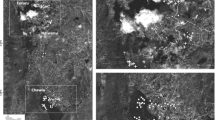Abstract.
In the Atlantic forest region, there is a need to develop economic activities that can be carried out in buffer zones around parks, with minimal impact on forest bird species. One such possibility is the farming of yerba mate, Ilex paraguariensis, under native trees. We compared bird speciesȁ9 presence and abundance between a forest reserve and an adjacent plantation of shade-grown yerba mate, to determine which species might use such plantations. Of the 145 species that were regularly recorded in the forest, 66%, including five globally threatened species, were also regularly recorded in the plantation. Most canopy species and tree trunk insectivores showed similar abundance in both habitats, but forest floor and understory species were absent from the plantation. Within the plantation, higher tree density did not lead to a greater abundance of forest birds. Yerba mate grown under native trees could be used to rehabilitate cleared land and allow recolonization by some Atlantic forest bird species.
Similar content being viewed by others
References
A. Aleixo (1999) ArticleTitleEffects of selective logging on a bird community in the Brazilian Atlantic forest Condor 101 537–548
Alves M.C. 1990. The Role of Cacao Plantations in the Conservation of the Atlantic Forest of Southern BahiaBrazil. M.A. thesis, University of FloridaGainesville.
C.J. Bibby N.D. Burgess D.A. Hill S. Mustoe (2000) Bird Census Techniques (Second Edition) Academic Press London and San Diego
InstitutionalAuthorNameBirdLife International (2000) Threatened Birds of the World Lynx Edicions and BirdLife Barcelona and Cambridge
J.E. Brower J.H. Zar (1977) Field and Laboratory Methods for General Ecology W.M.C. Brown Publishers DubuqueIowa
L. Calvo J. Blake (1998) ArticleTitleBird diversity and abundance on two different shade coffee plantations in Guatemala Bird Conservation International 8 297–308
C. Canaday (1997) ArticleTitleLoss of insectivorous birds along a gradient of human impact in Amazonia Biol. Conserv. 77 63–77 Occurrence Handle10.1016/0006-3207(95)00115-8
M.B. Christiansen E. Pitter (1996) ArticleTitleSpecies loss in a forest bird community near Lagoa Santa in southeastern Brazil Biol. Conserv. 80 23–32 Occurrence Handle10.1016/S0006-3207(96)00073-0
Cockle K. 2003. The Bird Community of Shade-grown Yerba Mate and adjacent Atlantic Forest in Canindeyú, Paraguay. M.Sc. thesis, Dalhousie University, Halifax.
B. Eibl R.A. Fernandez J.C. Kozarik A. Lupi F. Montagnini D. Nozzi (2000) ArticleTitleAgroforestry systems with Ilex paraguariensis (American holly or yerba mate) and native timber trees on small farms in Misiones, Argentina Agroforest. Syst. 48 1–8 Occurrence Handle10.1023/A:1006299920574
R. Greenberg P. Bichier A. Cruz Angon R. Reitsma (1997a) ArticleTitleBird populations in shade and sun coffee plantations in central Guatemala Conserv. Biol. 11 448–459 Occurrence Handle10.1046/j.1523-1739.1997.95464.x
R. Greenberg P. Bichier J. Sterling (1997b) ArticleTitleBird populations in rustic and planted shade coffee plantations of eastern Chiapas, México Biotropica 29 501–514
Guyra Paraguay 2004. Lista Comentada de las Aves de Paraguay, Annotated checklist of the Birds of Paraguay. Asunción.
International Bird Census Committee 1969. Recommendations for an international standard for a mapping method in bird census work. Bird Study 16: 248–255.
IUCN 2002. 2002 lUCN Red List of Threatened Species. www.redlist.org. Downloaded on 23 November 2002.
F.C. James S. Rathbun (1981) ArticleTitleRarefaction, relative abundanceand diversity of avian communities Auk 98 785–800
S.J. Marsden M. Whiffin M. Galetti (2001) ArticleTitleBird diversity and abundance in forest fragments and Eucalyptus plantations around an Atlantic forest reserveBrazil Biodiv. Conserv. 10 737–751 Occurrence Handle10.1023/A:1016669118956
J. Mazar Barnett M. Pearman (2001) Lista Comentada de las Aves Argentinas Annotated Checklist of the Birds of Argentina Lynx Edicions Barcelona
P. Moguel V.M. Toledo (1999) ArticleTitleBiodiversity conservation in traditional coffee systems of Mexico Conserv. Biol. 13 11–21 Occurrence Handle10.1046/j.1523-1739.1999.97153.x
N. Myers R.A. Mittermeier C.G. Mittermeier G.A.B. da Fonseca J. Kent (2000) ArticleTitleBiodiversity hotspots for conservation priorities Nature 403 853–858 Occurrence Handle10.1038/35002501 Occurrence Handle10706275
R. Ribon J.E.J Simon G.T. de Mattos (2003) ArticleTitleBird extinction in Atlantic forest fragments of the Viçosa region, Southeastern Brazil Conserv. Biol. 17 1827–1839 Occurrence Handle10.1111/j.1523-1739.2003.00377.x
R.A. Rice R. Greenberg (2000) ArticleTitleCacao cultivation and the conservation of biological diversity Ambio 29 167–173
H. Sick (1993) Birds in Brazil: A Natural History Princeton University Press Princeton
A.J. Stattersfield M.J. Crosby A.J. Long D.C. Wege (1998) Endemic Bird Areas of the World BirdLife International Cambridge
D.F. Stotz J.W. Fitzpatrick T.A. Parker SuffixIII. D.K. Moskovits (1996) Neotropical Birds: Ecology and Conservation University of Chicago Press Chicago and London
J. Terborgh S.K. Robinson T.A. Parker SuffixIII C.A. Munn N. Pierpont (1990) ArticleTitleStructure and organization of an Amazonian forest bird community Ecol. Monogr. 60 213–238
J. Terborgh J.S. Weske (1969) ArticleTitleColonization of secondary habitats by Peruvian birds Ecology 50 765–782
J. Thiollay (1994) ArticleTitleStructuredensity and rarity in an Amazonian rainforest bird community J. Trop. Ecol. 10 449–481
J. Thiollay (1995) ArticleTitleThe role of traditional agroforests in the conservation of rain forest bird diversity in Sumatra Conserv. Biol. 9 335–353 Occurrence Handle10.1046/j.1523-1739.1995.9020335.x
E.O. Willis (1979) ArticleTitleThe composition of avian communities in remanescent woodlots in southern Brazil Papéis Avulsos de Zoologia 33 1–25
J.H. Zar (1999) Biostatistical Analysis (Fourth Edition) Prentice Hall Upper Saddle RiverNew Jersey
Author information
Authors and Affiliations
Corresponding author
Rights and permissions
About this article
Cite this article
Cockle, K., Leonard, M. & Bodrati, A. Presence and Abundance of Birds in an Atlantic Forest Reserve and Adjacent Plantation of Shade-Grown Yerba Mate, in Paraguay. Biodivers Conserv 14, 3265–3288 (2005). https://doi.org/10.1007/s10531-004-0446-0
Received:
Accepted:
Issue Date:
DOI: https://doi.org/10.1007/s10531-004-0446-0




